Preface: Syrian regular forces continued the siege on several villages in Western Ghouta, such as Beit Jinn, Mazraat Beit Jinn and Mughr Al-meer, as the siege that was imposed on them since 2013, is still harvesting lives of more civilians, particularly parallel with the Syrian regular forces shelling these areas almost daily, as well as preventing access food and medical supplies to those areas, in addition to the departure of most medical staff following settlements[1] with the Syrian regular forces at the beginning of 2017. Anyway, according to Syrians for Truth and Justice/STJ reporter, what aggravated the siege power on those villages is making several settlements between Syrian regular forces and the adjacent villages such as Beit Saber, Beit Tema and Kafr Hawar at the beginning of 2017, those settlements resulted in handing over weapons and vehicles held by the armed opposition, joining the militants, existed in those villages, to the Syrian regular forces and restoring the services to them, and there were promises to release all detainees as well, but that had not been done. These settlements played a role in oppressing and tightening the siege on the villages of Beit Jinn, Mazraat Beit Jinn and Mughr Al-meer; some villages such as Beit Saber and Beit Tema became a starting point to shell the villages of Beit Jinn, Mazraat Beit Jinn and Mughr Al-meer. Moreover, doctors of those villages who used to provide medical services to the villages of Beit Jinn and Mazraat Beit Jinn were prevented to do that following the settlements.
At the beginning of September 2017, Syrian regular forces, backed by allied forces from villages such as, Hadar, Harfa, Maqrusa[2] and Heeneh[3], commenced a military campaign to control the besieged villages, which were the last stronghold of the Syrian armed opposition factions in western Damascus countryside. Syrian regular forces resorted to use all weapons, including barrel bombs, as well as warplanes and helicopters during this attack. However, that resulted in the death and injury of many civilians, as many people and eyewitnesses confirmed to STJ reporter in the beginning of October 2017.
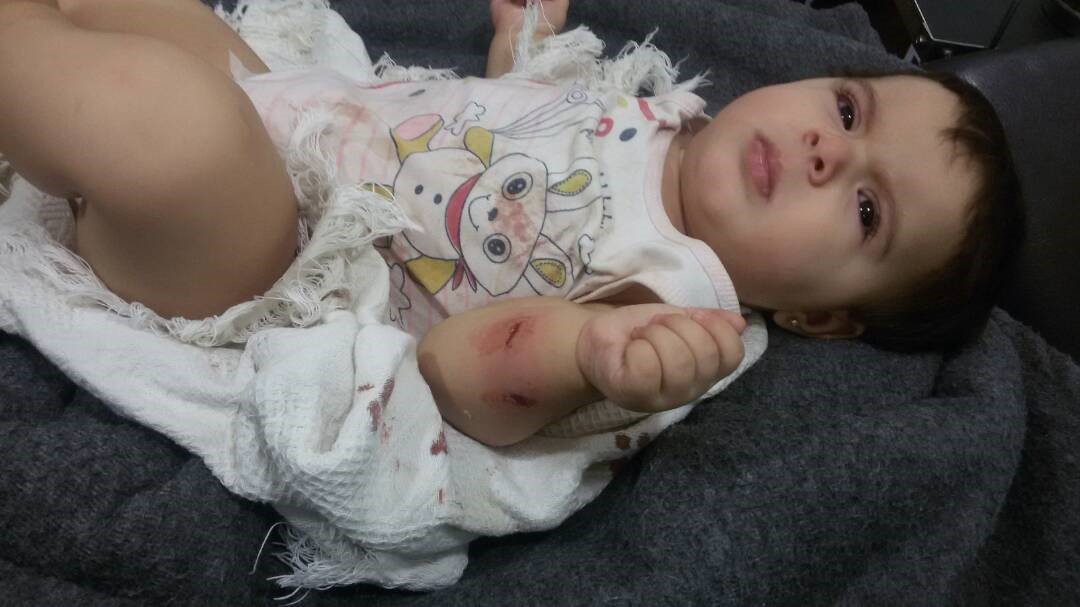
Image of a child injured with shrapnel from an explosive barrel that dropped by a warplane of the Syrian regular forces near her house in the village of Beit Jinn on August 31, 2017.
Photo credit: STJ
Political and Military Context
On September 14, 2017, the sixth round of Astana conference was held in the Kazakh capital, as there was an agreement between the sponsored states(Russia, Turkey, and Iran )on several points, according to the statement issued at the end of the conference. One of the points was declaration of establishing de-escalation zones in accordance with a referendum on May 4, 2017, which included Eastern Ghouta, parts of northern Homs, Idlib province and some parts of the adjacent provinces (Latakia, Hama and Aleppo), as well as some parts of southern Syria. The statement did not state whether Western Ghouta is within de-escalation areas or not.
Since 2012, armed Syrian opposition factions, presented by the Union of Jabal al-Sheikh forces[4], control several villages in Western Ghouta, such as Beit Jinn and Mazraat Beit Jinn, They also has control Mughr Al-meer, the Druze majority village since 2013, those villages considered to be the last strongholds of the Syrian armed opposition in Western Ghouta.
Syrian regular forces has imposed a siege on these villages since 2013, and since the beginning of 2017, they have made settlements with several adjacent towns such as (Beit Saber, Beit Tema and Kafr Hawar), and it has formed the so-called Harmon Regiment/Fawj al-Harmon[5] to participate in the fight against opposition factions there.
The besieged area lies in the west of Western Ghouta adjacent to the borders of the occupied Syrian Golan and Hadar town with the Druze majority, which is considered to be the beginning of extension of the northern countryside of Quneitra, that gives the region great strategic importance, particularly as it contains important high hills overlooking posts of the Syrian regular forces in Hadar like Altulul AlHumer. However, Syrian opposition factions have made several attempts since 2015 to control Hadar aiming to lift the siege and link the Western Damascus countryside with Quneitra reaching to the south of Daraa province. The last attempt was on November 4, 2017, when the Jabal al-Sheikh Operations Headquarter[6] announced in conjunction with the "Mohammed Army Operations Headquarter"[7] a battle called (Breaking Restrictions on Harmon), starting from the northern countryside of Quneitra towards Syrian regular forces posts in the vicinity of Hadar.
According to STJ reporter, the assault of the Syrian armed opposition forces caused a cavity along the border with the occupied Golan towards the village of Beit Jinn, but the Syrian regular forces backed by popular committees[8] located in Hadar, could recapture it on the same evening, which tightened the siege again on Western Ghouta villages.
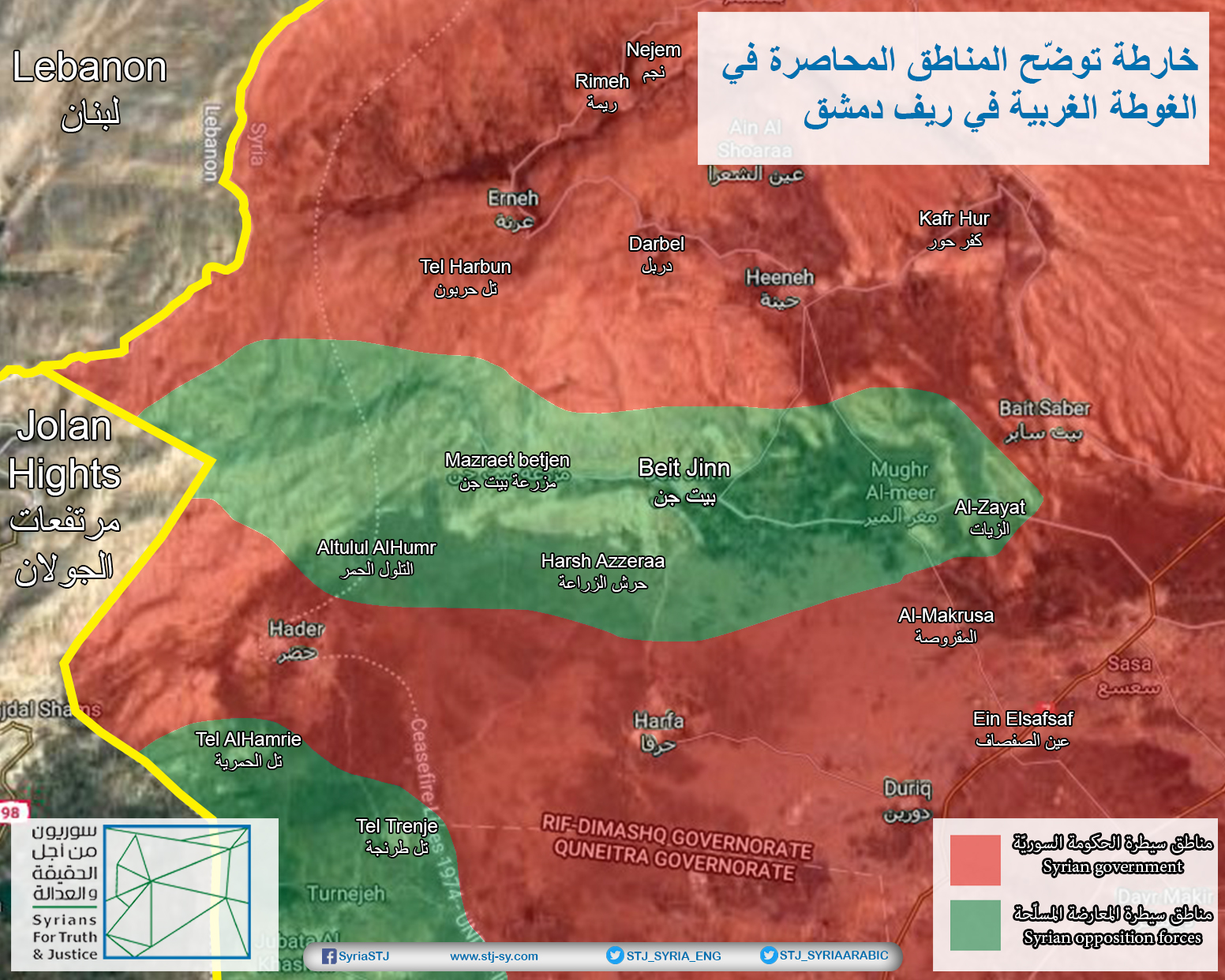
An illustrative map showing the besieged areas in Western Ghouta in western Damascus countryside.
First: Siege is Easier than the Security Branches
Inhabitants of the besieged areas in Western Ghouta exceed 3000, distributed in villages of Beit Jinn, Mazraat Beit Jinn and Mughr Al-meer, where they suffer difficult humanitarian conditions in the context of shortages of basic foodstuffs, especially after the Syrian regular forces blocked all ways that lead to Syrian armed opposition controlled areas in mid-2013. Most of the population depended on smuggling routes from adjacent areas (Sa'sa and Beit Saber) to ensure some basic foodstuffs, which are sold at high prices given the difficulty of getting them, the matter that was confirmed by Abu Moayed Janini, who hails from Beit Jinn village whose locals face difficulty in securing foodstuffs, he said to STJ:
“We suffer, in this village, from lacking most of the main food items, such as flour and sugar, as well as fuels, and if there are, they will be at very high prices, as the price of a bundle of bread reached (350) SYP, one kilo of sugar exceeded (700) SYP and the gasoline liter (400) SYP and likely rise by the arrival of winter. Anyway, these materials are brought from neighboring villages through extremely rag and dangerous routes, since regime forces are targeting all routs leading to besieged areas, and deliberately shelling them every day, so we are currently depending on vegetables grown in our besieged villages."
Abu Moayed added that the violent shelling on Beit Jinn by the Syrian regular forces is currently the most frightening matter to the people, particularly since the village does not contain any shelters that may protect them from shelling, that pushed many of them to shelter in some cellars. He gave an example of the violent shelling on the town in September 2017, when Syrian regular forces warplanes dropped more than 300 barrel bombs in addition to hundreds of shells launched from Tal Heeneh and Tal Darbel, located on the northern side of Mazraat Beit Jinn controlled by the Syrian regular forces, in this regard, Abu Moayed said:
“No one provides the needed medical aid in case someone injured in the shelling, since there is no medical point except for a single one that a dentist supervised it, and the other option is to go towards occupied Syrian territory via a rag road. What prevents us from a settlement with the Syrian regime was that we are worried about reprisals, since all the adjacent villages that had a settlement got little or no benefit; quite the opposite happened, as following numerous settlements, the regime forces took the young men to compulsory service, and arrested dozens of them, who were previously in sympathy with the armed opposition. In short, the blockade is easier for us than detention in the security branches and compulsory service."

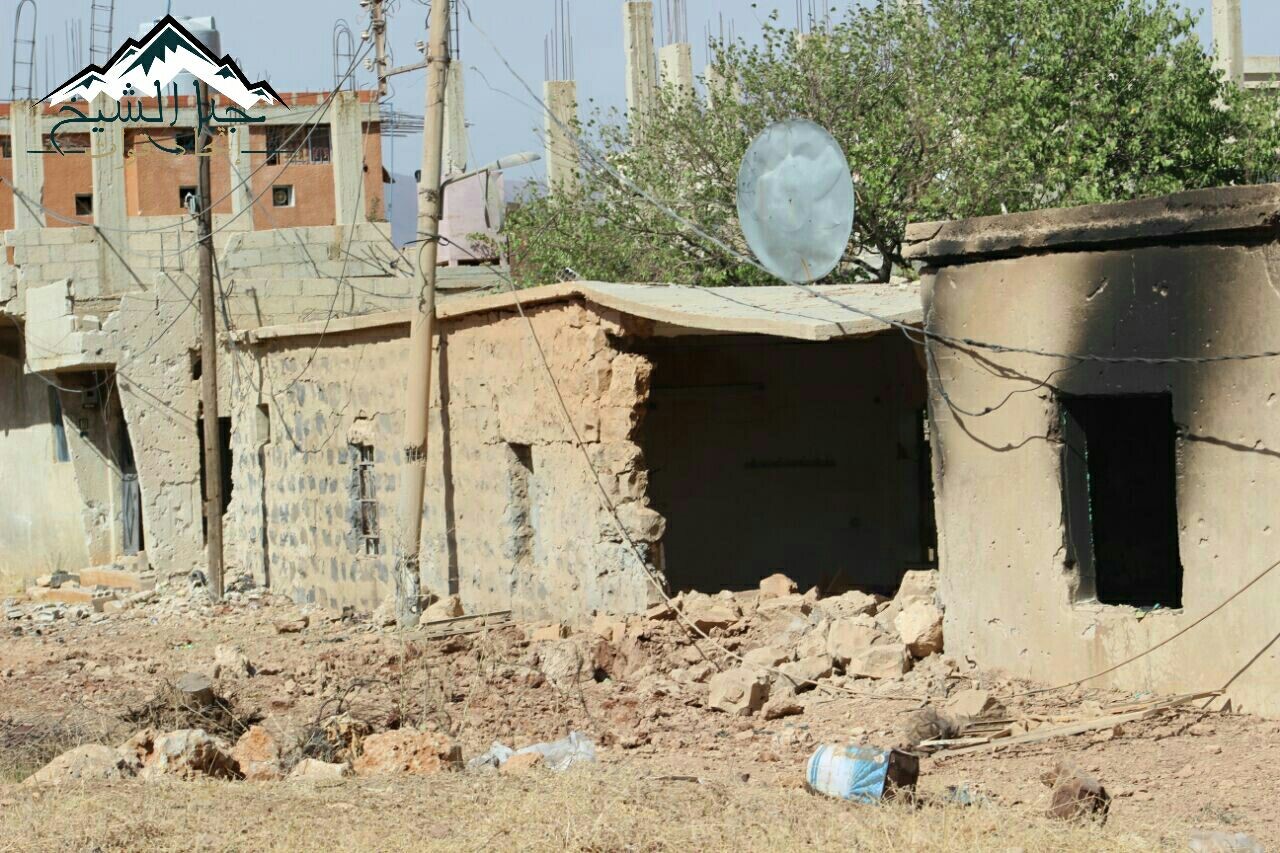
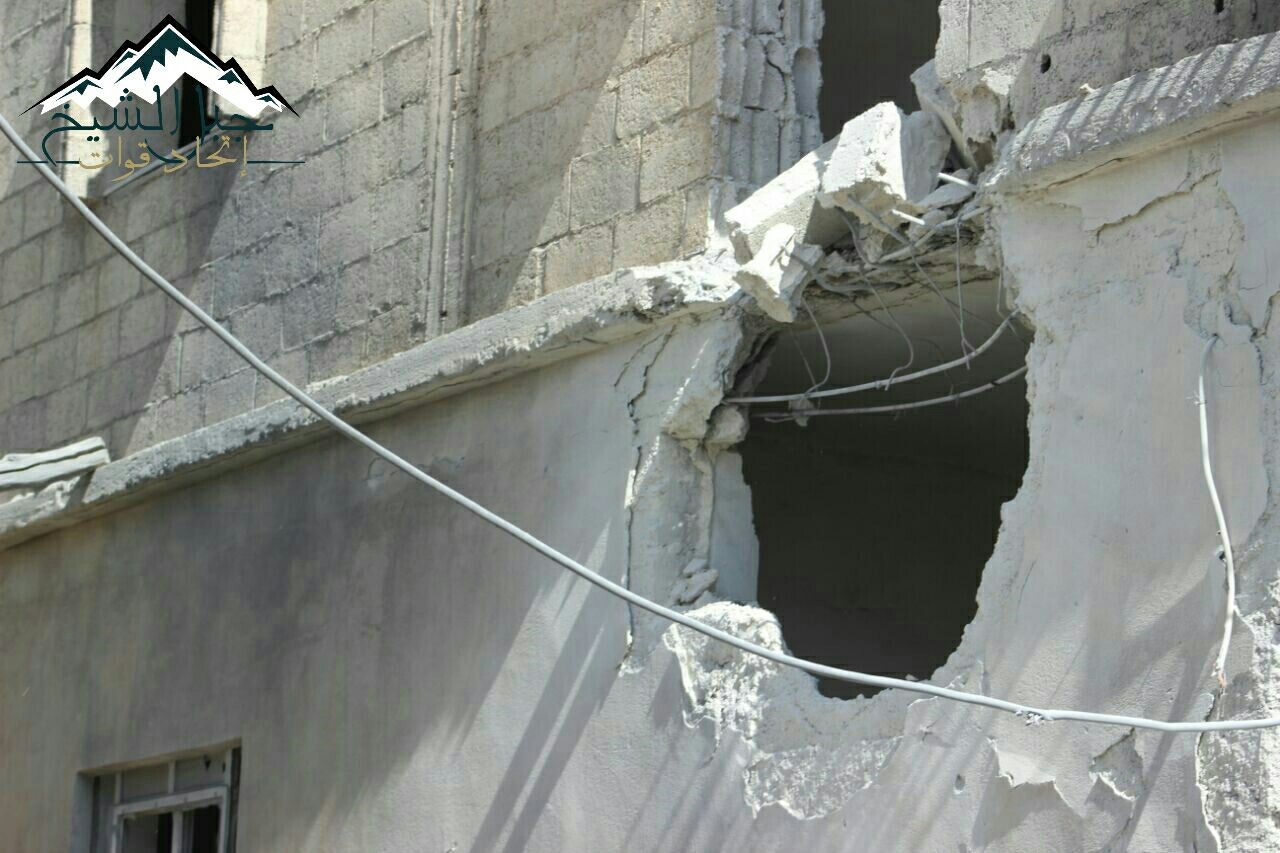
 Images showing a side of the destruction in the village of Mazraat Beit Jinn in western Ghouta, as a result of shelling by the Syrian regular forces on September 25, 2017,
Images showing a side of the destruction in the village of Mazraat Beit Jinn in western Ghouta, as a result of shelling by the Syrian regular forces on September 25, 2017,
Photo credit: the media office channel of the Union of Jabal al-Sheikh forces on the Telegram.
Second: Poor Medical Potential
Within the besieged areas of Western Ghouta there is one medical point run by the dentist, Hazem Abu Eyad, along with some volunteers received training during the period of the siege, particularly since most of the doctors and nurses of those areas had left following settlements with the Syrian regular forces and were prevented to enter those besieged areas at the beginning of 2017. In turn, the medical point supervises providing first aid to the injured, but refers the serious cases to the occupied Syrian territory to receive treatment, anyway, many of those injured died given the rugged mountain road and lack of transportation, in this regard, Dr. Hazem Abu Eyad talked to STJ:
“Following the settlements of the three villages (Beit Tema, Beit Saber and Kafr Hawar) with Syrian regime forces, and after installing several checkpoints separating them from besieged areas, the medical situation worsened more. We have been denied from services provided by doctors and nurses in those areas, and currently there is no specialist medical staff within the besieged areas, but only newly-experienced volunteers. It should be noted that our work is limited only to provide life-saving aid for critical cases in order to keep them alive, until they arrive to occupied Syrian territories. Many had died on the mountain road during transferring them to receive treatment, due to the fact that the injured were being transported on mules which increase the severity of the injury, not to mention the length of time that lasts sometimes more than three hours to get there. As for medicines, children's milk, and the medical equipment, it is difficult to secure them by getting them from regime control areas, owing to the high prices, so some medicines are introduced from the occupied Syrian territory."
Doctor Hazem continued that many humanitarian and medical organizations such as Médecins Sans Frontières/Doctors without Borders and Al-Sham Humanitarian Foundation had ceased to provide medical support for besieged areas, arguing that most doctors had reconciled with the Syrian regular forces, in turn, Hazem confirmed that casualties increased since the beginning of this year, more than 70 people were killed, in addition to dozens of wounded, the majority were due to fierce military campaign launched by the Syrian regular forces, precisely at the beginning of September 2017, as close to 35 people were killed and 50 wounded, and the toll is Increasing as a result of this campaign, doctor Hazem pointed out that a US medical staff had entered the besieged areas across the occupied Golan parallel with the conception of the military campaign, as this staff still provides some first aid to the injured of the heavy shelling on the civilians houses.
A video footage for STJ shows an injured civilian, in the shelling of the Syrian regular forces, while the medical staff was treating him within the medical point in the besieged village of Beit Jinn on October 11, 2017.
Another exclusive video footage shows an injured civilian in the shelling of the Syrian regular forces, as the injured was receiving treatment by the medical staff in the medical point in the besieged village of Beit Jinn, on October4, 2017.
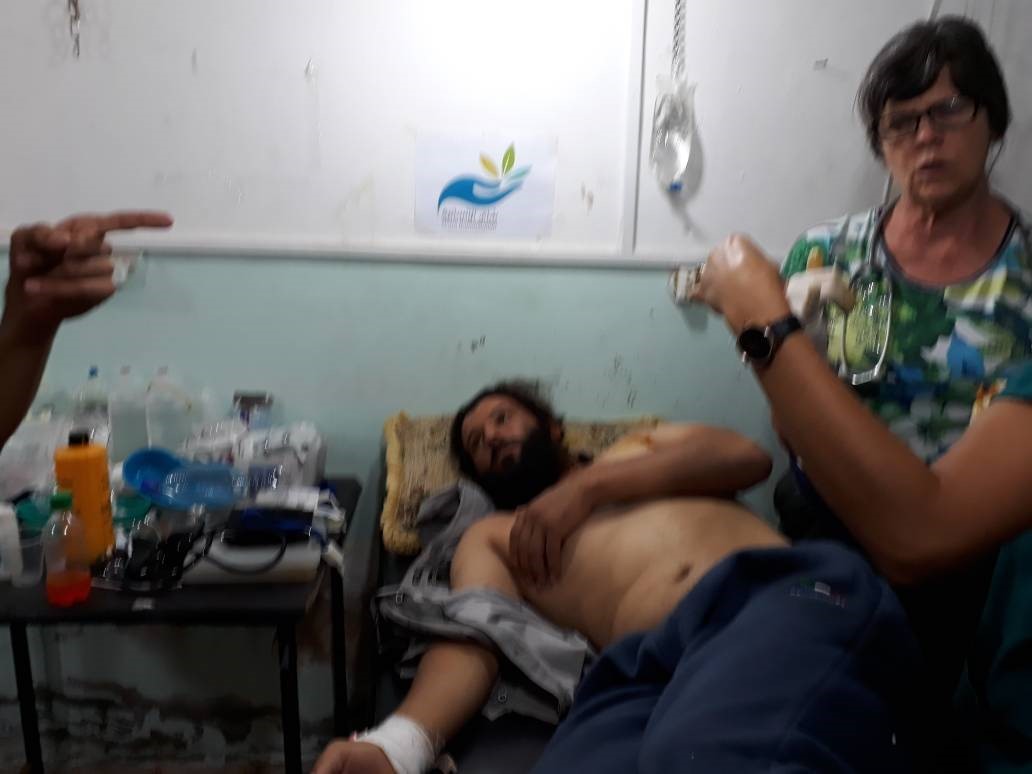 –
–
Image showing some of the injured civilians as a result of shelling the regular forces Beit Jinn at the beginning of October 2017, it also shows them receiving treatment by the American staff existed in the village.
Photo credit: STJ
Third: A violent Military Campaign against Besieged Areas
At the beginning of September 2017, Syrian regular forces, backed by the Lebanese Hezbollah and Fawj al-Hermon, launched a violent attack aimed to control Mazraat Beit Jinn village controlled by armed Syrian opposition factions that call themselves Union of Jabal al-Sheikh forces. Parallel with fierce bombardment by dropping dozens of barrel bombs on besieged areas resulted in scores of dead and injured among civilians and members of the opposition beside significant material damage to civilian houses, and in this regard, Abu Fayez, a media activist in Beit Jinn, said:
“A few months ago the besieged areas of Western Ghouta were subjected to artillery and mortar shelling by the regime forces and its loyal forces in Beit Saber, Hadar, Maqrusa, Beit Tema and Heeneh, not to mention dozens of barrel bombs that indiscriminately targeted civilian houses, leaving many dead and wounded. However, on September 10, 2017, regime forces launched a violent attack on Mazraat Beit Jinn and Beit Jinn villages in order to control them, alongside controlling strategically importance hills such as Altulul AlHumr, Safwat, Al-Zayat, AlThaher al-Aswad that were under the control of the armed opposition. Anyway, the offensive commenced from several axises, including Darbel axis, with the Sunni majority and the site of the forces of the 4th Division of the regime, the axis of Heeneh village with the Christian majority, Maqrusa axis with the Druze majority, and the axis of al-Thaher al-Aswad/Al-Zayat, Tell Bardaa)."
Abu Fayez alluded that the toll of the shelling on Mazraat Beit Jinn within 35 days following the onset the military campaign in the besieged areas, reached more than 500 barrels explosive, including 60 naval mines[9], 40 barrels containing incendiary materials, and 4000 assorted missiles, all of which have caused enormous destruction to the buildings, houses and civilian properties, that pushed some residents to flee towards Syrian regular forces control areas despite the gravity of the security situation that might be presented to arrest. Concerning the dead and wounded as a result of the shelling, Abu Fayez said that up to 35 people had been killed and up to 50 were injured, including women and children.
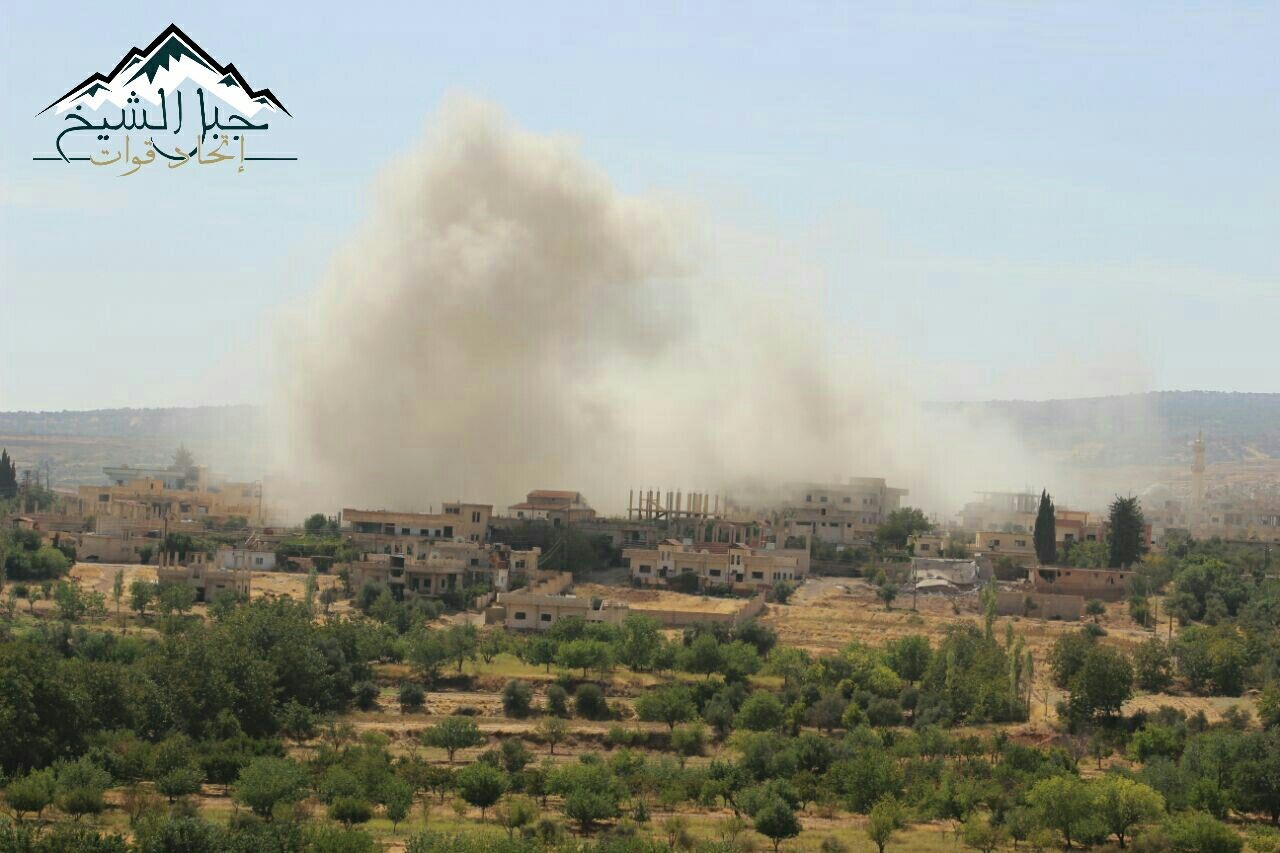
Image shows the rising smoke as a result of the shelling the village of Beit Jinn by Syrian regular forces warplanes on September 24, 2017.
Photo credit: the media office channel of the Union of Jabal al-Sheikh forces on the Telegram.
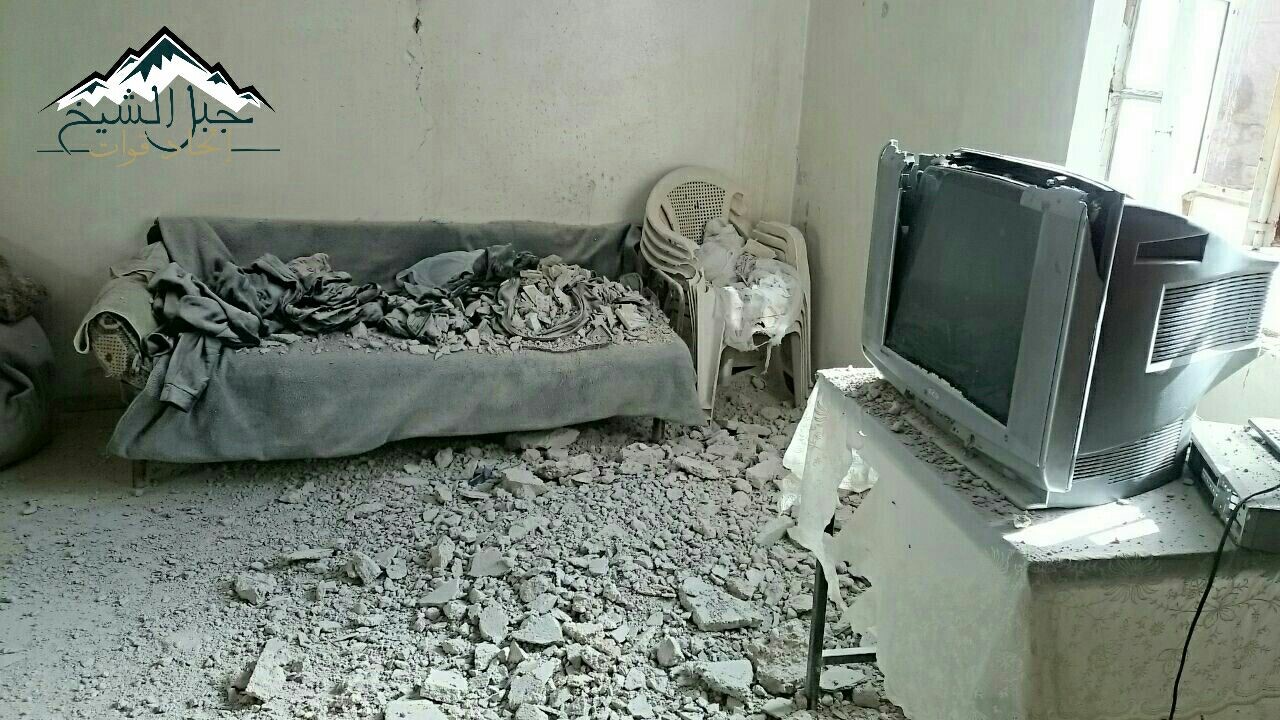
Another image showing destruction of civilian houses in Beit Jinn village, as a result of the mortar shelling by the Syrian regular forces on September22, 2017.
Photo credit: the media office channel of the Union of Jabal al-Sheikh forces on the Telegram.
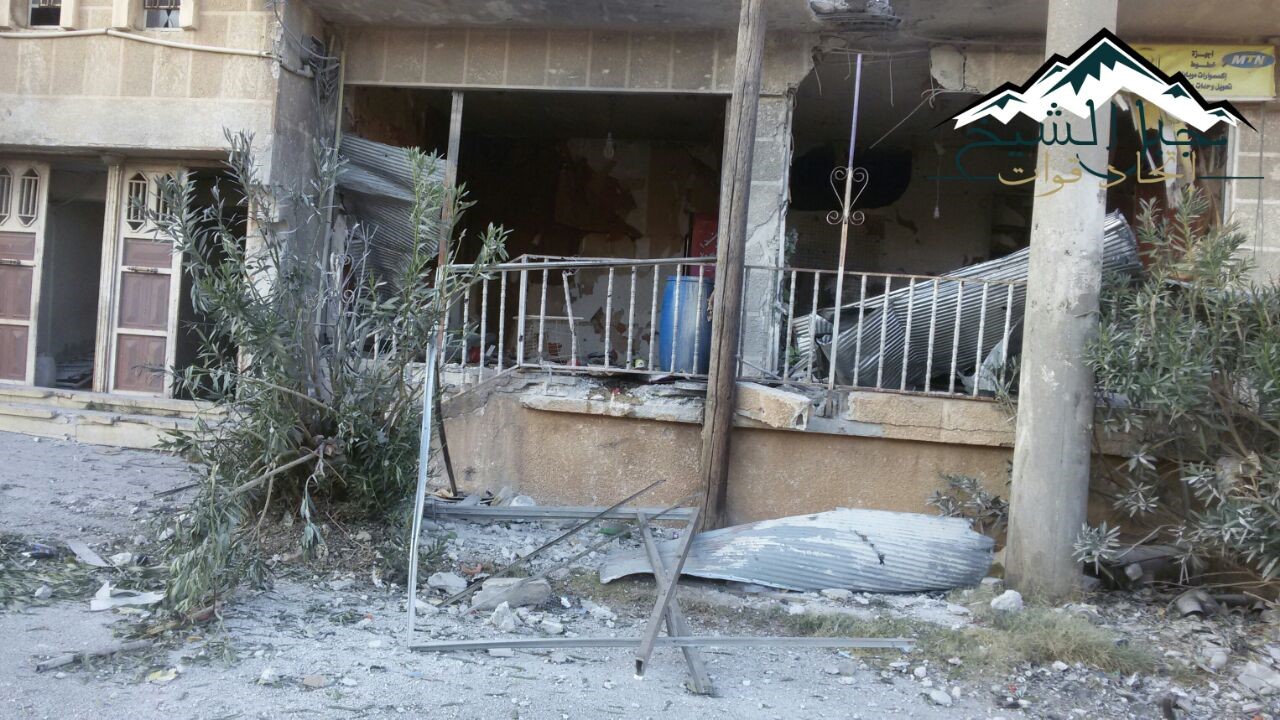
Another image showing devastation in the village of Mazraat Beit Jinn in Western Ghouta, as a result of shelling by the Syrian regular forces on October 2, 2017.
Photo credit: the media office channel of the Union of Jabal al-Sheikh forces on the Telegram.
For his part, STJ reporter documented the names of some of dead civilians in the villages of Mazraat Beit Jinn and Beit Jinn in the last attack on those areas by the Syrian regular forces in September 2017. It is worth mentioning that some of the names of the dead have not been published preserving the safety of the families of the dead who are still in the areas of control of the Syrian regular forces.
|
Number |
Name |
Status |
|
1 |
Fadi as-Sha’bee |
Civil child |
|
2 |
Amar Qablan |
Civil |
|
3 |
Ahmad Hamdan |
Civil |
|
4 |
Ahmad al-Badawi |
Civil |
|
5 |
Muhamed Qablan |
Civil |
|
6 |
Hussien abu-Assaf |
Civil |
|
7 |
Yousef Hamouda |
Civil |
|
8 |
Um Ali Hamdan |
Civil |
|
9 |
Um Suleiman Hamza |
Civil |
|
10 |
Muhamad Qasim Othman |
Syrian opposition faction |
|
11 |
Jihad Othman |
Syrian opposition faction |
|
12 |
Alaa Othman |
Syrian opposition faction |
|
13 |
Hussam Othman |
Syrian opposition faction |
|
14 |
Nabil Qablan |
Syrian opposition faction |
[1] Settlement means reaching to a particular type of agreement with Syrian government forces, including various items, such as breaking the siege, stopping shelling by the regular army, and introducing foodstuffs and other items. Items of the settlement vary from one region to another in Syria besides the term settlement differs from the terms of “truce or cessation of hostilities or cease-fire…". The settlement, in the Syrian context, refers to the neutralization of the area and put it under the control of the central government in Damascus.
[2] It is worth mentioning that the village of Hadar, Maqrusa and Harfa were majority Druze.
[3] The majority of Heeneh village inhabitants were Christian.
[4] It was formed in the beginning of 2017, as a result of union of six Syrian opposition factions, the most important were the Syrian Revolutionary Front, the Jabal al-Sheikh Brigade and Omar bin al-Khattab Brigade, Ahrar al-Sham al-Islamiyya as well as Hayat Tahrir al-Sham/HTS(al-Nusra Front), and it aims to break the siege of the besieged areas in West Ghouta.
[5] Formed at the beginning of 2017, specifically by locals of villages of Western Ghouta whom were settled with the Syrian regular forces (Beit Saber, Beit Tema and Kafr Hawar), it becomes an ally in its offensive on the besieged areas because they know the region's geography well, and the members of this formation had also participated in other battles In Syria alongside the Syrian regular forces.
[6] It was established on November 3, 2017, in the besieged villages of Western Ghouta, as it consists of Hayat Tahrir al-Sham/HTS and the Syrian Revolutionary Front.
[7] This headquarter was established on June 24, 2017, it aims to control the city of Al-Baath in Quneitra country side which is under the control of the Syrian regular forces. The headquarter consists mainly of Hayat Tahrir al-Sham/HTS, as well as a number of Syrian opposition factions, n

